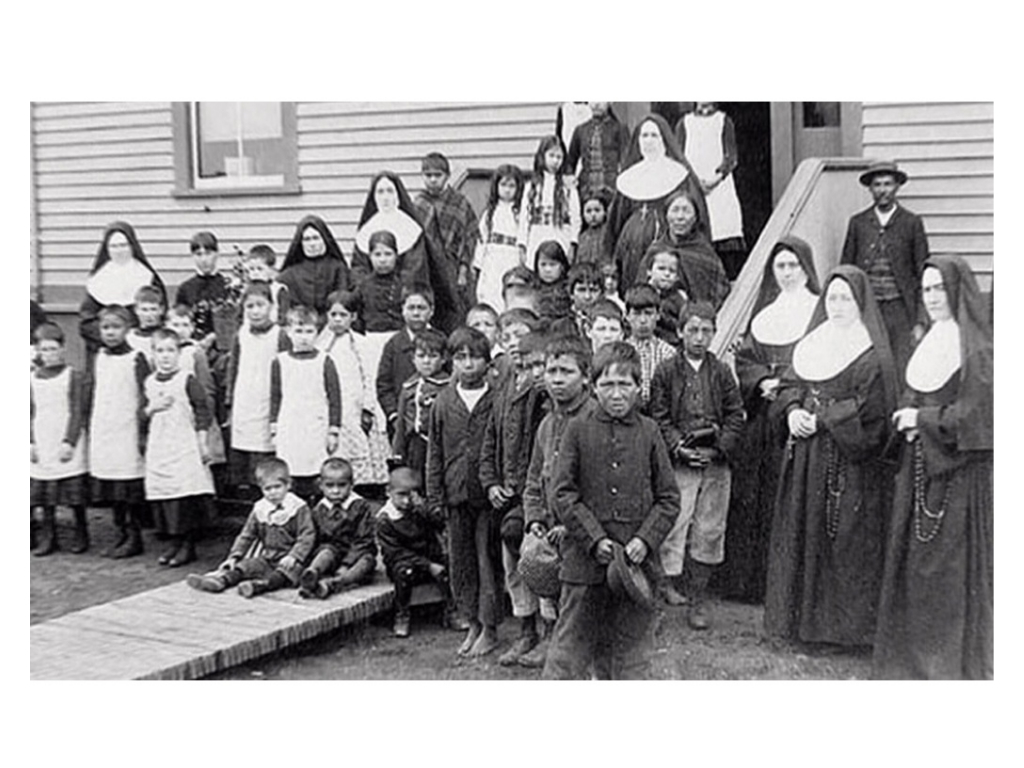
Our 2021 Roundup: Is It Time To Cancel The Catholic Church For Their Role In Canada’s Residential Schools?
Lifestyle Jan 13, 2022
Update: Since we ran this story on June 9th, in the light of the tragic discovery of 215 children in unmarked graves in Kamloops, there has since been a national outcry from the local, provincial and federal levels to investigate the other grounds of former residential schools across Canada
On June 24th, the same ground penetrating technology used in Kamloops, discovered 751 children in unmarked graves on the grounds of the former Marieval Indian Residential School located 140 km from Regina, Saskatchewan. This school — like the one in Kamloops — was also under the eye of the Roman Catholic Church. According to the Cowessess First Nation, there were reports that headstones of these graves may have been purposefully removed by the Catholic Church during the 1960s.
On June 30th, reports of another 182 children in unmarked graves were found near a former residential school near Cranbrook, British Colombia. This discovery is part of a nationwide search for other graveyards across the country.
At the same time, two key demands are being voiced across the country:
- With today being Canada Day, calls to cancel celebrations has been getting louder and louder, with some cities going ahead and presenting a subdued commemoration (Toronto), while others have gone ahead and officially cancelled Canada Day celebrations altogether understanding that fireworks are not appropriate when the country was built on the genocide of the Indigenous peoples. In addition, Prime Minister Trudeau has ordered the Canadian flag from the Peace Tower on Parliament Hill to be lowered today.
- Calls for an official Papal apology have also been ringing loud and clear. This has been going on for years. The Pope has released a statement yesterday, about plans to meet with residential school survivors this December. This story is still developing.
We feel that it’s important to keep the focus on the Indigenous community on this day. So in that spirit, we are asking this question once again.
The Catholic Church’s role has long been documented when it comes to aiding in the establishment of the Indian residential schools across Canada. Now with statues being dismantled, names being removed and institutions being questioned, it must be asked, is this the time to cancel the Catholic Church? In the spirit of National Indigenous Month, we take a closer look at the Church’s role and what should be done in the name of justice for Canada’s Indigenous peoples.
It was a grizzly discovery. On May 27th, the Tk’emlúps te Secwépemc First Nation released a statement indicating that through ground-penetrating radar, the bodies of 215 Indigenous children were found at the site of what used to be the Kamloops Indian Residential School.
Operated by The Oblates of Mary Immaculate a religious congregation of the Catholic Church, the Kamloops Indian Residential School (which was Canada’s largest residential school) functioned from 1893 to 1969. Initially, they resisted releasing any of their documentation pertaining to their school master lists. It wasn’t until they faced backlash on Twitter, when they retreated and explained via email to The National Post that their documents are actually listed with the Royal British Columbia Museum and are working with museum experts to track down and eventually release any documentation they may have. One of the many questions that continue to linger is that The Oblates only have 51 children registered as deceased, so what happened to the others?
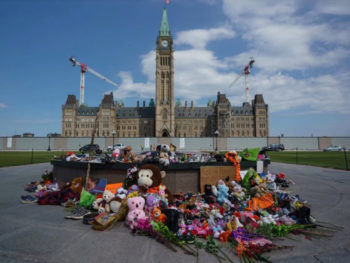
Since this discovery of these unmarked burials (Tk’emlúps te Secwépemc First Nation Chief Rosanne Casimir clarified the erroneous media reporting that these were “mass graves”) there has been a flurry of questions, anguish and heartbreak. One of the biggest questions is trying to understand the Catholic Church’s history of working with the Canadian government when it came to founding and operating these residential schools. These schools that spanned across Canada, were the site of unspeakable mental and physical and sexual abuse of Indigenous children often at the hands of the authorities running the school. It’s also worth noting that a decades-long sexual abuse of Indigenous children by priests from Missionary Oblates of Mary Immaculate in Quebec, have also come to light. All in all it’s a dark chapter in Canadian history. “History” is not even correct as the latest school was shuttered in as recently as 1996.
What Are “Residential Schools”?
A belief that was shared among those in the upper echelon of the Canadian government during the early years of the nation, was that in order to acclimate the First Nations community children would have to be forcibly removed from Indigenous households and brought to these residential schools to learn about the “white man” and his way of living.
The school’s mission was to deprogram the children so they can unlearn their Indigenous language, spiritual practices and their rich history and teach them a way of life deemed proper, in order to raise a generation of Indigenous children who can easily transition back into Canadian society.
Overseen by the Catholic Church it was Sir John A. Macdonald, the first Prime Minister of Canada who initiated the move, laying the groundwork for future politicians to follow. In a speech he gave to the Canadian House of Commons in 1883, Macdonald noted:
“When the school is on the reserve the child lives with its parents, who are savages; he is surrounded by savages, and though he may learn to read and write his habits, and training and mode of thought are Indian. He is simply a savage who can read and write. It has been strongly pressed on myself, as the head of the Department, that Indian children should be withdrawn as much as possible from the parental influence, and the only way to do that would be to put them in central training industrial schools where they will acquire the habits and modes of thought of white men.”
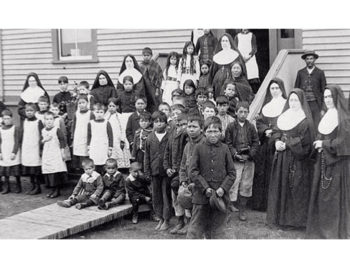
From that point forth, the residential school system expanded across Canada with over 130 federally supported residential schools, which housed approximately 150,000 Indigenous children through the years.
Documents which circulated for years through the various levels of the Canadian government and recently published by The National Post show just how much leverage these residential schools have had over Indigenous families and their children. One family feared they would have their food blockaded if they didn’t surrender their children, while staff in some schools simply didn’t understand why the Indigenous community didn’t appreciate the mission that they are trying to carry out. There were ledgers describing physical, sexual and mental abuse happening across all of the schools in the country.
This one letter just gutted me. It was penned in November 1948 by Principal O’Grady who ran the Kamloops Residential School. Yes the same school where the children’s bodies were just discovered. His belief that sending children back to their families for Christmas was a privilege extended by the school to the parents, complete with a threat that if the children didn’t come back to the school in time, they will not be sending their kids back home next year.
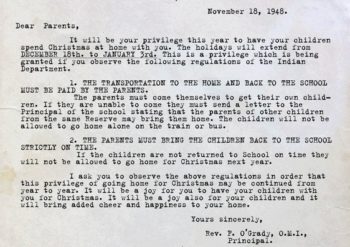
A 1933 letter from a student named Jeffries addressed to his father, described various disturbing incidents at Sechelt Residential School, which operated under a Roman Catholic staff from 1904 to 1973. The construction of the Sechelt Residential School was supported by The Oblates as well as the Roman Catholic Bishop of New Westminster, British Colombia.
Jeffries described the Sechelt Residential School as a “jail” where cost-cutting (which was common across all residential schools) deprived the children from proper meals.
“The food is pig food it is not fit for human beings to eat it. Some … apple core, rotten spuds and worms and rotten meat and they force us to eat it that why some boys get sick … this school is not a school at all, it is a jail house.”
Students were also not allowed to talk to any of their neighbours surrounding the school.
What Was The Catholic Church’s Role?
Anglican and United Churches did run some of the residential schools in Canada, however the majority of them were largely overseen by the Catholic Church. And The Catholic Church has largely been silent and uncooperative when it comes to fulfilling requests made by the Canada’s long-running independent inquiry, The Truth and Reconciliation Commission (TRC). TRC was launched in 2005 and ended in 2015 and it explored Canada’s long, dark history of Indigenous racism and mistreatment which included the residential school system. It came away with 94 recommendations to be carried out.
It’s also noted that the Anglican and United Church (in addition to the Canadian government) have all issued public apology for their role in the residential school system. The Catholic Church has not.
During these years, the National Centre of Truth and Reconciliation has been asking the Catholic Church for key documents pertaining to all of their schools. Instead, they were met with various versions of stonewalling and delays. Even though the Catholic Church had a longstanding order to abide by these requests, they remained largely silent. “These records are vital to understanding how the schools were run, who the children were, and why so many didn’t make it back home,” noted Tavia Grant in her article for The Globe & Mail. “They’re missing for many schools, including the Catholic-run Kamloops Indian Residential School.”
While addressing the House of Commons, Murray Sinclair, former chair of the TRC stated, “That there are still church records that have not been revealed or made available to the national centre or to us at the [Truth and Reconciliation Commission] that related to this is … a sad commentary on the lack of the commitment by the Catholic Church to allow us to investigate this further.”
The Catholic Church couldn’t even fulfill their financial obligation of paying out $25 million CAD, as part of a settlement for residential school survivors, only managing to raise a paltry $3.5 million CAD. While other Catholic organizations failed to provide documents when especially requested by Indigenous leaders.
Going to court didn’t motivate them to act either. TRC has brought the Church to court numerous time in order to pressure them to produce documents. But to no avail. Getting proper and authentic documentation is imperative. It gives TRC the opportunity to complete the picture of how these schools were run, getting the precise number of students who went through those doors and other master lists needed as steps towards justice for the survivors (and deceased) of residential school system. Many schools are left out of the minimal records that TRC has received thus far, including those from St. Anne’s school in Fort Albany, Ontario, where survivors have “described whippings, beatings, widespread sexual abuse, and punishment by shocks delivered in an electric chair”. But no records have been offered up to back up these claims.
The Pope’s Non Apology
During Sunday Mass, leaders of Canada’s Indigenous communities looked to The Vatican for some empathy but more importantly for a public apology. They didn’t get it. Pope Francis during his regular address to his congregation at St. Peter’s Square, expressed his “sorrow” and his “closeness” to the Canadian people. But it fell short of an full-throated apology, which perplexed and angered Indigenous leaders as well as those from the Catholic community.
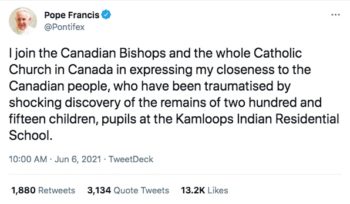
“I join with the Catholic church in Canada in expressing closeness to the Canadian people traumatized by the shocking news,” Francis said. “This sad discovery increases the awareness of the sorrows and sufferings of the past.” His address was positioned to quell the growing anger that was aimed at the Catholic Church for not publicly addressing the discovery of the unmarked burials sooner. It was also noted, that this address was the result of the Pope’s meeting with his two Canadian Cardinals on Saturday, who urged the Pontiff as the head of the Catholic Church to address the tragedy.
Dr. Rev. Carmen Lansdowne, the executive director at First United Church Ministry Society on Vancouver’s Downtown Eastside and a member of the Heiltsuk First Nation, expressed her disappointment upon hearing the Pope’s address. “He’s expressing ‘closeness’ to the Canadian people,” She told CityNews 1130. “It’s very clear that Canadian residential schools victimized and traumatized generations of Indigenous children and families, and that’s never acknowledged in anything that he’s released today.” It was also noted that Pope Francis didn’t even mention the survivors of the schools.
“This is still living history for us. The last residential school closed when I was in third-year university, and I’m only 45, “Landsdowne added. “This is the living history and the living legacy of residential schools and an assimilation of policy that was meant to eradicate Indigenous people from Canadian society. And every Canadian has to come to terms with that.”
Casimir also joins in on the call for a public apology from the Catholic Church.
And who else? The Truth and Reconciliation Committee as well. A formal apology from the Catholic Church is listed as one of their 94 recommendations.
So Now What?
The heartbreak from discovery of the 215 children in Kamloops has reverberated across the country. There has been calls to remove names from institutions, statues have been felled and a reckoning with Canada’s dark chapter when it comes to the country’s treatment of Indigenous peoples as a whole.
There are many examples of such dismantling taking place.
Protesters at Ryerson University brought down the statue of Egerton Ryerson who was also one of the architects of the Residential School System. The head was severed and launched into the nearby harbour. The university’s newspaper has decided to remove Ryerson’s name from their title, and the university itself is looking ways to handle the requests to have Ryerson’s name from the school itself. #XUniversity has now become the popular reference when talking about Ryerson.
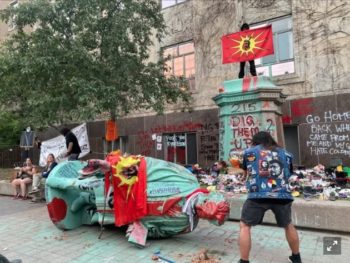
A school in Hamilton, Ontario, also named after Ryerson, has voted to change their name.
City councillors in numerous cities across Canada have voted to remove statues of Sir John A. Macdonald in Charlottetown Nova Scotia, Regina, Saskatchewan and Picton, Ontario.
There have been numerous petitions focusing on former Prime Minister Pierre Elliott Trudeau. One in Vaughn Ontario demanding that a statue of Trudeau to be removed from a city centre.
Another petition is asking to remove Trudeau’s name from Montreal’s Airport.
Now back to the Catholic Church.
It’s clear that the Catholic Church who also has a long history of inadequate responses and dismissive attitudes to incidents of decades-long sexual abuse among their priests, it’s clear they have a long way to go when it comes to accounting for their own sins. However, it’s clear that their refusal to cooperate with the Truth and Reconciliation Commission, coupled with the disappointing non apology by the head of the Catholic Church, they may need to face some sort of cancellation as part of the long road to justice for our Indigenous brothers and sisters.
It’s a cancellation which would clearly be their own doing.
Main Image Photo Credit: www.washingtontimes.com
Hina P. Ansari
Author
Hina P. Ansari is a graduate from The University of Western Ontario (London, Ontario). Since then she has carved a successful career in Canada's national fashion-publishing world as the Entertainment/Photo Editor at FLARE Magazine, Canada's national fashion magazine. She was the first South Asian in...













































































































